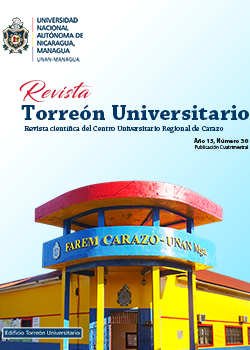Double integrals in the calculation of fluid flow density in a vector field
DOI:
https://doi.org/10.5377/rtu.v13i38.19126Keywords:
Double integrals, density, fluid, volumetric flow, vector field, educational assessmentAbstract
The objective of this article is to analyze the applications of double integrals in the calculation of fluid flow density in a vector field. The qualitative approach was applied, likewise, the documentary design was used because it is a descriptive study, in which basic concepts of integrals, vector fields, fluids, volume of solids, volumetric flow, properties and types of educational evaluations that are part of the backbone of this work are analyzed. Data collection was through the observation of videos on the YouTube platform, interviews with university teachers, textbooks and journal articles related to the topic of double integrals, vector fields and fluids. Likewise, for the analysis of the information it was necessary the triangulation of theories, taking into account the different points of view of the researchers regarding the topic in order to reach a conclusion and give a solution to the two unpublished problems posed through the analysis of different physical and mathematical variables, which are related to the interdisciplinary nature of integral calculus, vector calculus and fluid mechanics. For the analysis of the results it was necessary to solve two problems in order to put into practice everything analyzed and described in the theoretical reference and thus fulfill the objectives of the work.
Downloads
References
Álvarez, C. A. (2011). Metodología de la investigación cuantitativa y cualitativa. Obtenido de https://www.uv.mx/rmipe/files/2017/02/Guia-didactica-metodologia-de-la-investigacion.pdf
Bejarano, M. A. (2016). La investigacion cualitativa. INNOVA Research Journal. Obtenido de https://scholar.google.es/scholar?hl=es&assdt=%2C5&q=estudio+
cualitativo+concepto&oq=#d=gs_qads&t=16
&u=%23p%3DsHfujMSalJQJ
Benavides, M. O., & Gómez Restrepo, C. (2005). Metodos en investigacion cualitativa: triangulación. Revista Colombiana de Psiquiatría, 123. Obtenido de https://scholar.google.es/scholar?/hl=es&as_sdt=0%2C5&q=triangulacion+
de+teorias&oq=#d=gs_qads&t=1664513429
&u=%23p%3DCWzTJnm8qQUJ
León, R. d. (2016). Tipos de paradigmas. Obtenido de Cursos online web: https;//cursosonlineweb.com/paradigmas.html
Rogawski, J. (2012). Cálculo de varias variables segunda edición. Barcelona, España : Editorial Reverte, S. A. Obtenido de https://es.scribd.com/document/501849039/calculo-de-varias-variables-Rogawski
Downloads
Published
Issue
Section
License
Copyright (c) 2024 National Autonomous University of Nicaragua, Managua

This work is licensed under a Creative Commons Attribution-NonCommercial-NoDerivatives 4.0 International License.
The authors who publish in this journal agree to the following terms.
- The author or authors of the articles, essays or research grant the National Autonomous University of Nicaragua, Managua (UNAN-Managua) the editing rights (copyright) of the submitted work, therefore the University has the exclusive right to publish the article for the entire copyright period.
- These copyrights/authors authorize Torreón Universitario Magazine and the University to edit and disseminate/publish the article in said Magazine, including printed and electronic reproduction, storage, retrieval and any other type of publication, and sources of secondary information as services. of summaries and databases, they also empower it to protect the article against unauthorized use for dissemination by printed or electronic media (PDF, HTML, EPUB, XML or others).
License for use of content
The magazine uses the Creative Commons Attribution-NonCommercial-NoDerivs 4.0 International License.
Under this statement:

This journal is licensed under a Creative Commons Attribution-NonCommercial-NoDerivatives 4.0 International License. It can be copied, distributed and transmitted publicly as long as the author and source are cited (Revista Torreón Universitario), it should not be modified or used for any commercial purpose. The full license can be found at http://creativecommons.org/licenses/by-nc-nd/4.0/.



